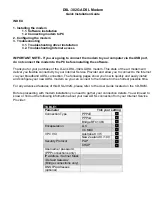
120 20130-101a
GeminiG3 – 700MHz User Manual
40
GoTo
Available in Test Mode only. Forces the unit to the specified channel (enabled or not).
Enable All
Selects all non-zero frequency fields
Disable All
Deselects all non-zero frequency fields
Apply
Activates the “Enable All” or “Disable All” selection
Output P
o
wer
Ad
j.
Limit power to
100% = Sets power to typically 27 Watts (700MHz model)
75% = Power limiting setting
50% = Power limiting setting
10 Watts = Sets power to minimum power setting
After selecting power setting, click on the “Apply” button, then on “Save Config”
RSSI Table
Main Raw = Raw dBm value from main radio receiver
Main Cal = Calibrated dBm value from main receiver DSP
Diversity Raw = Diversity raw dBm value from diversity radio
Diversity Cal = Calibrated dBm value from diversity receiver DSP
Range
-120 to –40 dBm
RSSI
Thresholds
-90 to –60 dBm
Test tone:
Select the desired test tone, press the “Execute” button to transmit a test signal on the channel se-
lected for 20 seconds or until the “Cancel current test” button is pressed.
The functions of all the other buttons are inoperative during test transmissions.
1 kHz sine wave
Test transmission generates a carrier modulated with 1kHz sine wave, at deviation level that
depends on mode of operation and network speed.
This function is frequently used for checking frequency deviation.
100 Hz square
wave
Starts a test transmission of a carrier modulated by a square wave. used to check low-
frequency balance at a frequency of 100 Hz
Modulated
Test transmission generates a carrier modulated with a test tone to check deviations. For
specific test tone and/or deviation values, see the relevant table in the Gemini G3 User
manual.
Unmodulated
Test tone is an unmodulated carrier that gives a clear carrier and used for checking:
♦
Frequency error
♦
Forward and reverse power
Power check:
Connect an in-line power meter between the radio and the antenna.
Measure the forward (nominal 27W) and reflected power levels by pressing the Execute
button. Never exceed 1W of reflected power.
Test Tones
Random Data
Starts a test transmission of a 20 seconds modulated carrier with random data
Random data test transmissions are used for checking low-frequency balance and maxi-
mum deviation over data.
•
Low-frequency balance check:
Helps to determine if the radio transmitter is well balanced for data transmission.
Refer to the User manual for values indicated in adjustment tables under “Low Fre-
quency Balance” step.
•
Maximum deviation check:
Helps to verify if the unit is within FCC regulation emission masks.
Refer to the User manual for values.
Random data test requires the use of an IFR COM-120B service monitor with option 03=
30KHz IF filter and its DC coupled demodulator output selected.









































